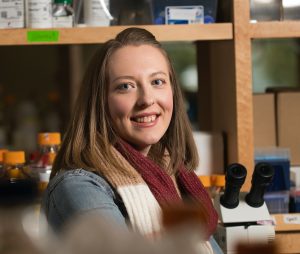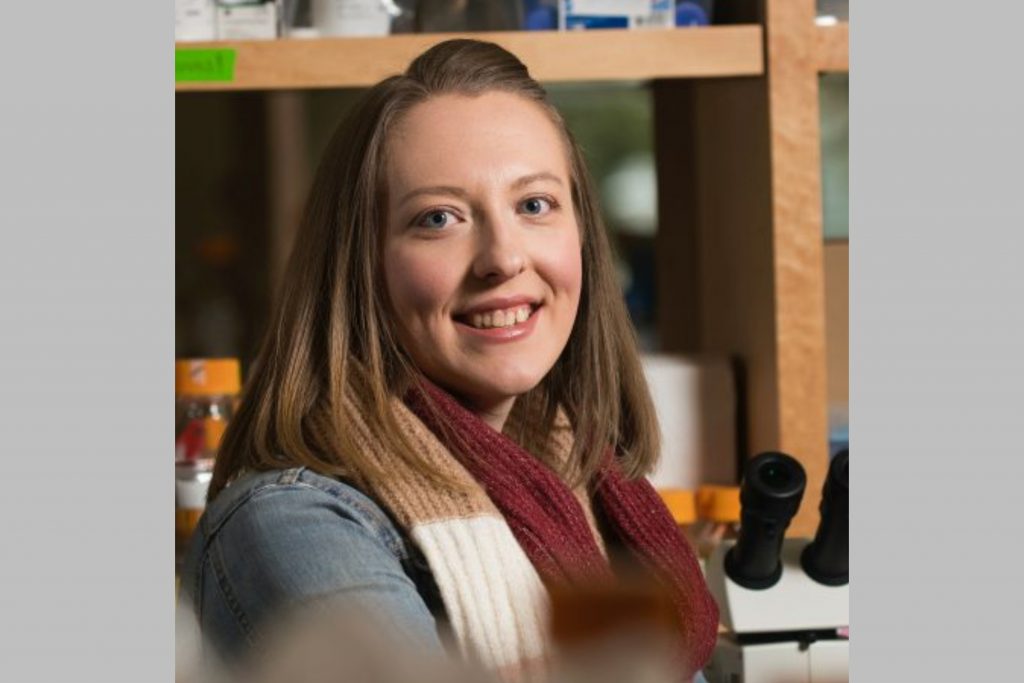We’re taking time to get to know the members of the GSA’s Early Career Leadership Committees. Join us to learn more about our 2020 early career scientist advocates.

Elisabeth Marnik
Subcommittee: Communication and Outreach
Department, Institution: MDI Biological Laboratory/Science Department, Husson University, Bangor, ME
Career Stage: Postdoc/Rising new assistant professor.
Research Interest
Somatic cells and germ cells both have the same DNA, yet germ cells have the ability to become every cell type that makes up a new organism while somatic cells remain their specific cell type. This ability of germ cells to differentiate into all cell types is called totipotency and is crucial for ensuring propagation of the next generation because it enables reproduction and subsequent development of a whole organism. Since the DNA of both of these cell types are the same, we want to determine what other factors are responsible for these striking cellular differences. One explanation is germ granules, which are unique to the cytoplasm of germ cells. Germ granules are clusters of RNA and proteins that sit on top of the exit from the nucleus. In the nucleus, DNA is made into RNA, and then the RNA must exit into the cytoplasm to be made into protein.
Thus, in germ cells, RNA must pass through these germ granules to reach the cytoplasm. One function of these germ granules is thought to be regulating which RNAs are made into protein. When germ granules are impaired, RNA and proteins are often mistakenly present in germ cells when they should only be in somatic cells. This is harmful for a germ cell because the presence of somatic proteins can impair the ability of the germ cell to differentiate into all of the cell types needed to make a new organism. As a result, sterility or other fertility defects often occur when the components of germ granules are impaired.
My research is focused on using the model organism Caenorhabditis elegans to understand the function of proteins within the C. elegans germ granule, called P granules, and how they help maintain germline integrity and totipotency. I am particularly interested in how these factors may be contributing to the formation of cancer cells. Mis-expressed germ cell proteins in cancer are called cancer testis antigens (CTAs), and research has shown that severe cancer prognoses correlate with the presence of CTAs. One hypothesis for this correlation is that the expression of CTAs gives cancerous cells a selective advantage and may be driving their harmful pathology.
My focus is on germ granule proteins in C. elegans with human homologs that are often found misexpressed in cancer cells, such as the GLH family of proteins and LOTR-1 in C. elegans. Both of these help regulate what RNAs and proteins are found within germ cells, but how and exactly what they’re doing is still being determined in both humans and C. elegans. If we could understand how these proteins function normally in the germline, we could begin to understand what they may be doing in cancerous cells. My hope is that this knowledge could then help us target the function of CTAs in cancerous cells and lead to the development of better-targeted cancer treatments.
As a PhD-trained scientist, you have many career options. What career paths interest you the most?
I came to science with the help of high quality mentors, particularly a group of amazing professors I encountered during my undergraduate degree at Central Connecticut State University. These professors made a profound impact on my life trajectory. I was raised in a poor family by a single mother who did not have the opportunity to attend college. This meant that my family was not equipped to help me navigate the challenges of higher education or a career in science. Then, right before my senior year in college, my family hit a particularly rough patch. I came very close to dropping out of college so that I could find a full-time job to help support my family. These professors found out, helped me realize what I would lose by quitting, and provided me with support so I could finish college successfully. They also encouraged me to pursue a PhD because they saw the potential I had in science. When they told me that I should pursue a PhD I was shocked—I had never fathomed that I was capable of pursuing anything beyond a Bachelor’s Degree! Thanks to them I opened my eyes to this possibility and decided to pursue a PhD at Tufts University through a collaborative program they had with the The Jackson Laboratory.
These supportive individuals made me realize how important professors who are truly passionate about educating and supporting their students are. As a result, when I entered into my PhD program I did so with the intention of becoming a university professor so that I could help students the same way my professors helped me. My time in graduate school affirmed my choice. My research during this time was focused on using mice to understand the immune system and what factors, such as genetic mutations or cellular changes, contribute to autoimmune disease. I enjoyed this research, but my PhD mentor encouraged me to also explore science outreach and teaching. These experiences really proved to me that while I love research, my true passion is and always has been science education and outreach. So my goal has remained pursuing a faculty position at a primarily undergraduate institution, where I can use my research to teach students how amazing and important science is.
Until my PhD defense I had only ever used mice as a model organism. As I researched more about the kinds of colleges and universities I wanted to work at, I realized that staying with mice could be prohibitive due to the facility and cost requirements. So I intentionally chose to do a postdoc at The MDI Biological Laboratory where I could work with a mentor who would support these career goals, and where I could switch my research focus to using C. elegans. It was a big switch! Pretty quickly though, I realized how awesome it is to work with a model organism that doesn’t bite or pee on you and reproduces in less than a week!
Since I planned this postdoc with the intention of honing my skills, I also began working to increase my teaching experience through several avenues. These included guest lecturing at universities and working with the education department at my postdoc institution to develop outreach programs for K-12 students and courses for varying ages.
Thankfully, I was recently hired and am now starting my position as an Assistant Professor of Molecular Biochemistry at Husson University, where I will be teaching undergraduates and using my research with C. elegans to give them hands-on science experience.
In addition to your research, how else do you want to advance the scientific enterprise?
I think one of the greatest downfalls of this generation has been the erosion of trust in science. I am convinced that part of this issue arises from failures in science communication and science education at the earliest levels. Most people rely on the media for their science, and oftentimes the media overstates or misinterprets the information, which subsequently erodes trust in science. My goal is to help bridge this gap by communicating science directly to people of all ages so that they understand the process of science and why it is important in their daily lives. I am particularly interested in targeting students K-12 and undergraduates with research written specifically for them, as well as targeted outreach programs.
My passion for science outreach led me to develop a 4th grade program for a local school district that introduces students to the process of science and using model organisms to learn about human health. I have run this program for three years now with great success. I have also hosted many one-day outreach activities for students in high school and gone into after school programs in rural communities to teach students about DNA and how scientists use microscopes. Since COVID-19 has limited in-person opportunities, I have taken my science outreach virtual! Early in the pandemic I recorded a video for The MDI Biological Laboratory explaining how PCR works (in the context of COVID-19 testing) and how kids can extract DNA from strawberries at home.
In addition to these outreach activities, I do as much as I can to improve science communication, especially right now when misinformation regarding COVID-19 is rampant. For now, most of this work is occurring within my personal social circles. However, I have helped assemble a resource page on science communication for the GSA so that other scientists can find resources for starting and improving their science communication efforts.
My goal is to continue these outreach activities as well as to bring my science communication to more public sources. My work on the Communication and Outreach Subcommittee is helping me do this. I have a few pieces I am working on with other members that will hopefully be published soon!
As a leader within the Genetics Society of America, what do you hope to accomplish?
I am honored to be a member of the GSA Early Career Leadership Program as part of the Communication and Outreach Subcommittee. The goal of this committee is to improve communication between scientists as well as the communication of scientists with the general public. One of my target outreach age groups has always been students in K-12. Since I have already done a lot of work with this age group, I am excited to bring that knowledge to this subcommittee in the hopes that we can expand some of our work to include interactions of young students directly with scientists.
I believe that my passion and experience for science communication, education, and outreach really makes me a perfect fit for this subcommittee. I greatly admire the work the subcommittee has already done in writing pieces for other scientists and the general public, and I am excited to be involved in new projects.
List your previous leadership experience (up to 5)
- Science Outreach Coordinator – MDI Biological Laboratory
- Chair of the Postdoctoral/Predoctoral Committee at MDI Biological Laboratory
- Alfond Leader – Finance Authority of Maine
- Chair of the Predoctoral Committee at The Jackson Laboratory, Bar Harbor, ME.
Connect with Elisabeth Marnik:































